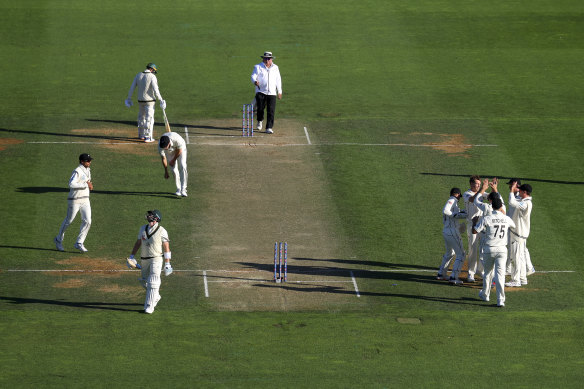- Analysis
- Sport
- Cricket
- Australian cricket
Freak moments or gradual decline: What Steve Smith’s dismissals as an opener say about his future
Christchurch: Steve Smith’s move up to opening was not a matter of universal consensus within the Australian team.
It was more a case that Smith lobbied so ardently for the role that captain Pat Cummins and the selectors were ultimately won over by how the move would refresh their leading batter and also allow Cameron Green to bat in his preferred number four slot.

Steve Smith walks off after his second innings exit in Wellington.Credit: Getty
Four matches in, Australia’s decision-makers are yet to reach a point of certainty about the move, in the sense that they feel a bigger sample size is required. But nine months between Tests, and those against the World Test Championship leaders India, will provide plenty of food for thought.
Back in January, the alternative scenario was to have Green opening alongside Usman Khawaja, while Smith stayed at four - a configuration that also had its supporters in and around the team.
Ultimately, Smith’s request was granted on the basis that he would not have the option of shifting back down after a few low scores. It was as an opener that Smith would spend the remainder of his Test career, however long that lasted. That assurance has until November to be tested.
Before this series, Smith had spoken of how he made the switch partly so he could put himself under pressure, feeling as though it was that sort of tension that helped him to play at his very best.
“I just feel when I put pressure on myself I just get a bit sharper in my movement. A bit more eccentric in my movements, my calling, it just gets me going a bit more. I try to find ways at stages to put more pressure on myself so I can get into that mindset.”
Smith’s movements have certainly been eccentric over four Tests against the West Indies and New Zealand, but with only one score of note in that time, the exaggeration does not appear to be helping him. And in terms of pressure, it is Smith’s top order teammates who are now feeling it as much as the 34-year-old himself.
“Test cricket is tough, you’re playing different conditions, played seven games in the last couple of months, it’s tough,” Cummins said when asked about Smith. “We’re pretty adamant these are our best six batters.
“Of course you’re always looking at how your batting unit functions, how you’re going to pick the best batting unit to try to perform, but we’re really happy with how the boys are going. No doubt a few of them will look back and wish they’d scored a few more runs, but basically everyone in the lineup has won a match this summer.”
To look back over Smith’s dismissals over these four matches against West Indies and New Zealand is to see either a couple of freak moments against new bowlers in Test cricket plus a couple of very good, seaming deliveries and a drag on. Or it is to glimpse the gradual deterioration of a great player towards the level of mere mortals.
Shamar Joseph’s dismissal of Smith with his first ball in Test cricket was a case of a very well-directed delivery given how far Smith moves across the crease. Similarly Ben Sears’ first Test wicket with his third ball here had just the right line and movement to create some indecision.
A pair of lbw dismissals to Kemar Roach at the Gabba and Matt Henry at Hagley Oval both showed how Smith’s big pre-movement across the crease have made him vulnerable to seam movement back in from outside off stump. The Gabba dismissal was explained away at the time as the result of a lot of sideways movement. But Henry was able to recreate it almost perfectly here.
Close observers of Smith see him having some issues with the rhythm of his pre-ball movements - that exaggeration when under the pressure he is telling himself he wants to feel - but also an absence so far of enough proactivity to put bowlers off.
That, of course, was a hallmark of how Smith put together his 2019 Ashes masterclass. The seaming ball was less of a problem because England found it so hard to keep Smith from a state of almost perpetual movement and rapid scoring.
Those innings brought about the negative tactics that New Zealand’s Neil Wagner and others used subsequently, packing the leg side or mainlining on short balls to reduce Smith’s scoring rate and ideally lead to his dismissal.
But upon moving up the order and facing the brand-new ball, Smith so far has not been out to bouncers or leg side fields. It’s been good quality, orthodox seam bowling that has brought him undone. So far, he has been unable to find a positive response.
That, perhaps, relates to the most immutable fact of all. Smith is not getting any younger. Older players, no matter how good they are, tend to worry more about what they have to lose from failure than what they have to gain by success.
Australia’s selectors, then, have a parallel dilemma. What do they gain from keeping Smith at the top of the order, relative to how much more they might lose by persisting with a move that was not necessarily their first instinct to make?
News, results and expert analysis from the weekend of sport sent every Monday. Sign up for our Sport newsletter.